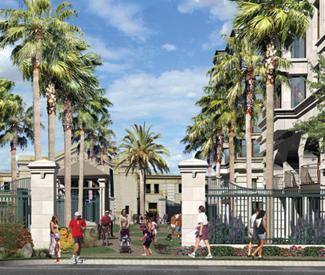Brad Benson, the special projects director at the Port of San Francisco, took me on a tour of the 8 Washington project and gave me his pitch for why the city ought to allow a developer to put the most expensive condos in city history, housing for the top half of the top half of the top 1 percent, on a prime piece of waterfront land. He showed me the fence around the existing Golden Gateway Tennis and Swim Club (it’s not terribly attractive) and I watched a powerpoint presentation on the glories of the project.
His argument: The Port has no money, and no easy way to get any money, to do the roughly $2 billion worth of maintenance needed on the its piers and property. Residential development on a few seawall lots is part of the Port’s master plan and part of a waterfront plan that won approval of the Port Commission and the (mostly corrupt) Board of Supervisors in the 1990s.
The Port will eventually realize roughly $100 million from the deal. The city will get about $11 million for affordable housing. There will be new parks and open space, and a new, way fancier swimming pool and aquatic center. The tennis courts will be gone (Benson told me that tennis isn’t the best use for that valuable land) but the club will shuttle tennis players to another facility South of Market.
Just an aside: This is often deried as a private club, and it is — in the sense that you have to join and pay membership dues. It’s open to anyone who wants to pay, much as the YMCA is. It’s a bit more expensive than the Y, way more expensive than my gym (which has no tennis courts and a tiny two-lane lap pool) and a good bit less expensive than the high-end places lilke the Bay Club. It’s not a recreation facility for poor people, by any means. It has relatively middle-class users, particularly the folks who live in rent-controlled apartments at Golden Gateway, who get a discount. It’s not clear at this point if the club fees will go up when the fancy new version is unveiled, but I’d be shocked if the swim club attached to the priciest new housing in the city was affordable to the rest of us.
Now then: Back to the project. If you look at all the pretty architectural drawings and see all the amenities, like the new park and the wider sidewalks and the street-level retail and restaurants (ya think those will be a bit out of the normal person’s price range? Ya think?), it all looks lovely.
Money for the port. Money for the city’s general fund. Affordable housing money. What’s not to like?
Well, I told Benson, who used to work for Tom Ammiano is someone I’ve been friendly with for years, the same thing that I’ve told other city officials, including a few supervisors:
If this is the kind of housing we’re building, if this is the population our housing policy caters to, if this is what San Francisco is going to become, then nothing else really matters.There will be no progressive movement in this city. There will be no crazy, wild culture. To quote Calvin Welch: “Who lives here, votes here.” And the richer the city gets, the more conservative it gets.
And, frankly, the more boring it gets.
We’re seeing that already. The 20,000 new (rich) residents of District 6 voted for Jane Kim, and they may continue to vote for her as long as she supports things like the Twitter tax break, but they wouldn’t have voted for Chris Daly. And when Kim is termed out, the next D6 supervisor is likely to be a lot more conservative. The wild SOMA culture is going to vanish. How many of these condo-dwellers will go to, or even tolerate, the How Weird Street Fair? How many will want to put an end to the Folsom Street Fair?
Yeah, the rich who move into this city support same-sex marriage and like bicycle lanes on the streets. But they aren’t going to push higher taxes. They aren’t going to support politicians who have at their core a belief that narrowing the gap between the rich and the poor is the most important issue facing this city and this country today. They’d probably vote for Scott Wiener over David Campos for state Assembly. They’ll blent the city’s edge, make it just like so many other places in the world.
The city’s own policy makes clear that 60 percent of all new housing should be below market-rate. Every new project for the rich that we approve skews the balance a little further away from housing for the majority of people who work in the city. Teachers, firefighters, hotel workers — they can’t afford this stuff. So they move further out of town, taking longer commutes, using more energy … it’s all wrong.
That’s why the May 15 vote on this project matters. Not because most of us will ever swim or play tennis at the Golden Gateway club one way or the other. Not just because the new buildings are too tall. Not because 134 units of uber-rich condos at 8 Washington will gentrify the Mission. It matters because, day by day, wek by week, condo approval by condo approval, we’re losing San Francisco.

